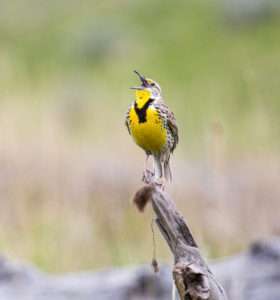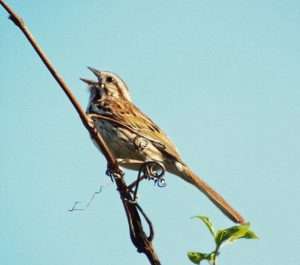 Summer is nearly halfway through, and while the days are still long there are already changes hinting at fall’s arrival. The heat causes some of the leaves on trees and shrubs to begin to turn just a little, and the sunset is a bit earlier each evening. One phenomenon that often startles people is when they realize that–seemingly overnight–the birds stopped singing.
Summer is nearly halfway through, and while the days are still long there are already changes hinting at fall’s arrival. The heat causes some of the leaves on trees and shrubs to begin to turn just a little, and the sunset is a bit earlier each evening. One phenomenon that often startles people is when they realize that–seemingly overnight–the birds stopped singing.
Now, it’s not unusual for them to quiet down when a predator passes by (that includes us big, scary humans, by the way.) After all, they don’t want to be noticed by something that would happily turn them into a snack. But with each passing week there are fewer birdsongs in the daily chorus, and by the end of August pretty much all the birds stopped singing. Why is that?
Well, first we need to look at why birds sing in the first place. I start noticing songs late in winter, and then the diversity and frequency build up throughout spring. This is correlated with nesting season. Both male and female birds sing, though male songs have historically been given more attention.
Songs serve to establish and protect territory in which mated pairs of birds build their nests; birds of the same species know that this spot is taken, move along, please–or else. And they also help birds to attract their mate for the year; male songs in particular have been studied in this regard. So what sounds like lovely music to us is serious business for birds, meaning either “Hey, baby, check ME out!” or “GET OFF MY LAWN!” (Birdsong is also more surprisingly complex than we had assumed!)
The singing continues throughout nesting season. Some species of bird only raise one clutch of young a year, especially those whose young may take several weeks to fledge. Others, especially many songbirds, can raise two or even three clutches a year, seeing their young fledge and leave the nest within two weeks of hatching. As long as the nest is active, the parent birds work actively to protect it, to include re-establishing residency through song.
 There is, of course, a risk associated with singing. Birds aren’t the only animals noticing the singer; predators also use these songs to home in on a potential meal. Singing does increase the likelihood of becoming prey, but it’s effective enough in helping spread one’s genes that it’s worth the risk from an evolutionary perspective. A bird that gets nabbed while singing near a nest is more likely to have passed its genes through at least one clutch of eggs, and if the surviving parent can get some of the young to fledgling age, then they have a good chance of surviving to spread the singing genes on to the next generation.
There is, of course, a risk associated with singing. Birds aren’t the only animals noticing the singer; predators also use these songs to home in on a potential meal. Singing does increase the likelihood of becoming prey, but it’s effective enough in helping spread one’s genes that it’s worth the risk from an evolutionary perspective. A bird that gets nabbed while singing near a nest is more likely to have passed its genes through at least one clutch of eggs, and if the surviving parent can get some of the young to fledgling age, then they have a good chance of surviving to spread the singing genes on to the next generation.
As soon as the nest is empty for the year, and the last batch of young have successfully fledged, the birds stopped singing. Why keep bringing attention to yourself when you no longer need to? It’s time to transition to non-breeding behavior patterns, whether that means a solitary existence, or a social group for winter.
But there’s another reason birds quiet down this time of year. By this point, their feathers are pretty beat up from their spring migration (even many resident species still engage in local migrations), and then defending their nests and literally running themselves ragged getting food for demanding, hungry young. They have to prepare for the fall migration, which for many species is a marathon thousands of miles long to their wintering grounds.
If you’re a bird whose flight feathers in your wings and tail are torn and even broken, you aren’t going to be a very efficient flier. Each wingbeat is going to cost you more energy, and on a long journey that inefficiency can be fatal. So July and the first part of August are prime times for North American birds to molt, shedding out old feathers and growing fresh new ones. By the time they’re ready for liftoff for the fall migration–or simply surviving winter’s cold right here–those shiny, undamaged feathers are going to be the perfect tools for energy-efficient flight. By saving valuable calories, they increase the likelihood that they’ll survive to see another breeding season next year.

But while they’re molting, they’re going to be additionally hindered in flight. That makes them even more vulnerable to predation. So this is another great reason for birds to quiet down as summer winds on. (They also may look a little silly, and while they probably don’t feel embarrassed about losing all the feathers on their head, I wouldn’t blame them if they were, in fact, a little self-conscious about it.)
Never fear, though–once late winter arrives next year, we’ll get to start hearing our birds warming up their syrinxes again, and soon the mornings will be full of the dawn chorus, fresh and new.

Thank you, Rebecca, for this incredible article!
Thank you so much! I’m really glad you enjoyed it.